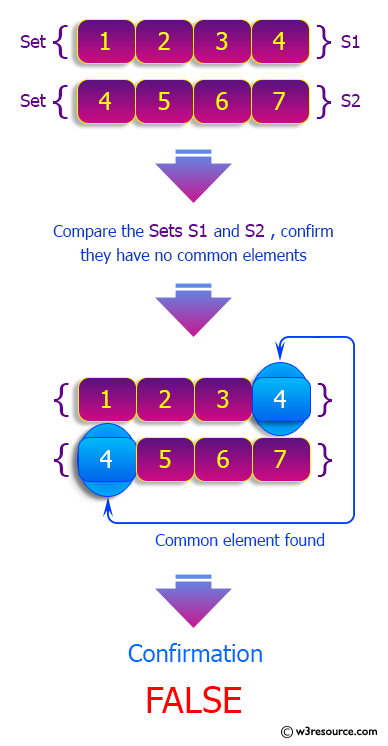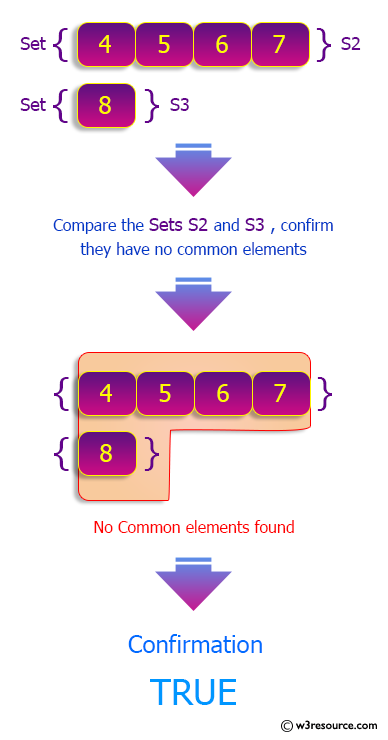Python: Check if two given sets have no elements in common
17. Check if Two Sets Have No Elements in Common
Write a Python program to check if two given sets have no elements in common.
Visual Presentation:



Sample Solution-1:
Python Code:
# Create sets 'x', 'y', and 'z' with different elements.
x = {1, 2, 3, 4}
y = {4, 5, 6, 7}
z = {8}
# Print a message to indicate the original set elements.
print("Original set elements:")
print(x)
print(y)
print(z)
# Print a message to confirm that two given sets have no common elements.
print("\nConfirm two given sets have no element(s) in common:")
# Print a message to indicate comparing sets 'x' and 'y'.
print("\nCompare x and y:")
# Use the 'isdisjoint()' method to check if 'x' and 'y' have no common elements and print the result.
print(x.isdisjoint(y))
# Print a message to indicate comparing sets 'x' and 'z'.
print("\nCompare x and z:")
# Use the 'isdisjoint()' method to check if 'x' and 'z' have no common elements and print the result.
print(z.isdisjoint(x))
# Print a message to indicate comparing sets 'y' and 'z'.
print("\nCompare y and z:")
# Use the 'isdisjoint()' method to check if 'y' and 'z' have no common elements and print the result.
print(y.isdisjoint(z))
Sample Output:
Original set elements:
{1, 2, 3, 4}
{4, 5, 6, 7}
{8}
Confirm two given sets have no element(s) in common:
Compare x and y:
False
Compare x and z:
True
Compare y and z:
True
Sample Solution-2:
Python Code:
# Define a function 'compare_sets' to check if two sets have no common elements.
def compare_sets(s1, s2):
for i in s1:
if i in s2:
return False
return True
# Create sets 'x', 'y', and 'z' with different elements.
x = {1, 2, 3, 4}
y = {4, 5, 6, 7}
z = {8}
# Print a message to indicate the original set elements.
print("Original set elements:")
print(x)
print(y)
print(z)
# Print a message to confirm that two given sets have no common elements.
print("\nConfirm two given sets have no element(s) in common:")
# Print a message to indicate comparing sets 'x' and 'y'.
print("\nCompare x and y:")
# Call the 'compare_sets' function to check if 'x' and 'y' have no common elements and print the result.
print(compare_sets(x, y))
# Print a message to indicate comparing sets 'x' and 'z'.
print("\nCompare x and z:")
# Call the 'compare_sets' function to check if 'x' and 'z' have no common elements and print the result.
print(compare_sets(x, z))
# Print a message to indicate comparing sets 'y' and 'z'.
print("\nCompare y and z:")
# Call the 'compare_sets' function to check if 'y' and 'z' have no common elements and print the result.
print(compare_sets(y, z))
Sample Output:
Original set elements:
{1, 2, 3, 4}
{4, 5, 6, 7}
{8}
Confirm two given sets have no element(s) in common:
Compare x and y:
False
Compare x and z:
True
Compare y and z:
True
Flowchart:

For more Practice: Solve these Related Problems:
- Write a Python program to determine if two sets are disjoint using the isdisjoint() method.
- Write a Python program to check for common elements in two sets using set intersection and return True if none are found.
- Write a Python program to implement a function that takes two sets and returns True if they share no common elements.
- Write a Python program to compare two sets using the & operator and verify that the result is an empty set.
Go to:
Previous: Write a Python program to check if a given value is present in a set or not.
Next: Write a Python program to check if a given set is superset of itself and superset of another given set.
Python Code Editor:
What is the difficulty level of this exercise?
Test your Programming skills with w3resource's quiz.
